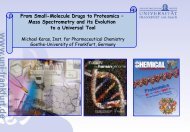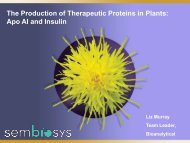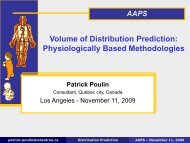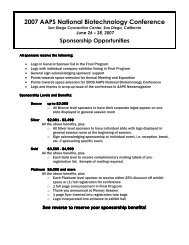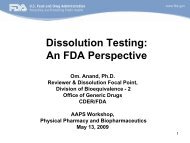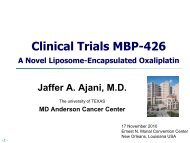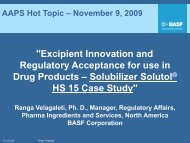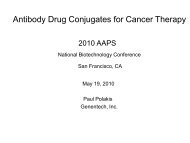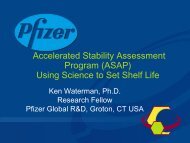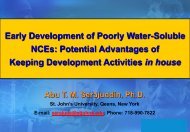Preliminary Program - American Association of Pharmaceutical ...
Preliminary Program - American Association of Pharmaceutical ...
Preliminary Program - American Association of Pharmaceutical ...
You also want an ePaper? Increase the reach of your titles
YUMPU automatically turns print PDFs into web optimized ePapers that Google loves.
62<br />
2009 AAPS Annual Meeting and Exposition<br />
Physical Pharmacy and Biopharmaceutics (PPB) <strong>Program</strong>ming<br />
formulation scientists and analytical scientists for<br />
exploration <strong>of</strong> high energy solids and facilitating<br />
technical breakthroughs in this field.<br />
Moderators<br />
Ping Gao, Ph.D.<br />
Abbott Laboratories<br />
Jun Huang, Ph.D.<br />
Bristol-Myers Squibb<br />
Crystallization <strong>of</strong> Amorphous Drug in Solid<br />
Dispersions<br />
Lynne Taylor, Ph.D.<br />
Purdue University<br />
Development <strong>of</strong> Amorphous Solid Dispersions:<br />
Formulation Selection and Risk Management<br />
Feng Qian, Ph.D.<br />
Bristol-Myers Squibb<br />
Assessing the Commercialization Potential <strong>of</strong><br />
Solid Dispersions<br />
Marshall D. Crew, Ph.D.<br />
Agere <strong>Pharmaceutical</strong>s, Inc.<br />
Wednesday, November 11, 2009<br />
WEDNESDAY MORNING SYMPOSIA<br />
Funded by a Grant from<br />
8:30 am – 11:00 am<br />
Extrapolation Preclinical Data to<br />
Predict Human Pharmacokinetics:<br />
Understanding and Practice<br />
Symposium<br />
Screening, understanding, and optimizing the in<br />
vivo performance <strong>of</strong> drug products is required to<br />
achieve desirable clinical efficacy target and safety<br />
pr<strong>of</strong>iles in patients. Even though the drug products<br />
are ultimately investigated in human, the use <strong>of</strong><br />
human subjects is clearly limited by ethical concerns<br />
and restrictions <strong>of</strong> cost. As the use <strong>of</strong> animal models<br />
in drug research and development is evident, careful<br />
and educated utilization <strong>of</strong> this preclinical approach<br />
is required. In this symposium, understanding<br />
<strong>of</strong> physiologies <strong>of</strong> animal species relevant to<br />
PK assessment will be highlighted. Attempts <strong>of</strong><br />
using animal models to increase the precision<br />
and accuracy <strong>of</strong> PK predictions and to enable a<br />
better understanding <strong>of</strong> complex ADME behavior in<br />
humans will be discussed.<br />
Moderators<br />
Lillian (Hua) Zhang, Ph.D.<br />
U.S. Food and Drug Administration<br />
Jennifer J. Sheng, Ph.D.<br />
AstraZeneca<br />
Integrated Approaches in Utilizing Preclinical<br />
Models for Human Predictive Absorption<br />
Bertil Abrahamsson, Ph.D.<br />
AstraZeneca<br />
Volume <strong>of</strong> Distribution Prediction:<br />
Physiologically Based Methodologies<br />
Patrick Poulin, Ph.D.<br />
Consultant in <strong>Pharmaceutical</strong> Research<br />
Prediction <strong>of</strong> Human Hepatic Metabolism and<br />
Clearance from In Vivo Animal Experiments<br />
Duxin Sun, Ph.D.<br />
University <strong>of</strong> Michigan<br />
Scaling Pharmacokinetics/Pharmacodynamics<br />
from Animal Studies to Humans<br />
William J. Jusko, Ph.D.<br />
University at Buffalo, The State University<br />
<strong>of</strong> New York<br />
WEDNESDAY AFTERNOON ROUNDTABLES<br />
2:00 pm – 4:00 pm<br />
Salts, Co-crystals, Polymorphs/Solvates,<br />
Nanoparticles, or Amorphous: How to<br />
Pick the Winner<br />
Roundtable<br />
In the past the most common approach was to<br />
choose the most stable crystalline form to go<br />
forward into development. However, many <strong>of</strong> the<br />
new drug candidates have extremely poor solubility,<br />
which can result in poor bioavailability. There are<br />
multiple methods to increasing the bioavailability<br />
<strong>of</strong> a compound, including generating a salt form,<br />
a metastable crystalline form, a co-crystal, a<br />
nanoparticle formulation, an amorphous form, or<br />
an amorphous dispersion. Choosing which form is<br />
<strong>of</strong>ten a balance between the benefits <strong>of</strong> enhanced<br />
solubility/bioavailability and the detriment <strong>of</strong><br />
form interconversion to a different form and<br />
correspondingly reduced bioavailability. In this<br />
roundtable the speakers will discuss the advantages<br />
and disadvantages <strong>of</strong> choosing each <strong>of</strong> the different<br />
forms, including the issues <strong>of</strong> producing a less<br />
stable form that does not interconvert and the scaleup<br />
and manufacturing <strong>of</strong> metastable forms.<br />
Moderator<br />
Brian Padden, Ph.D.<br />
Abbott Laboratories<br />
Introduction to Methods to Increase Solubility:<br />
Salts, Co-crystals, and Amorphous Solids<br />
Ge<strong>of</strong>f Zhang, Ph.D.<br />
Abbott Laboratories<br />
Co-crystals: The Future <strong>of</strong> Improving<br />
Solubility?<br />
Nair Rodriguez-Hornedo, Ph.D.<br />
University <strong>of</strong> Michigan<br />
Which to Choose? A Contract Lab Perspective<br />
Rolf Hilfiker, Ph.D.<br />
Solvias AG<br />
2:00 pm – 4:00 pm<br />
Tumor Targeting Using Nanotechnologybased<br />
Drug Delivery Systems<br />
Roundtable<br />
The method <strong>of</strong> delivery plays an important role in<br />
ensuring that the drug reaches its target site for<br />
therapeutic effect. Novel modes <strong>of</strong> delivery methods<br />
using nanosphere technology are receiving wide<br />
attention as these have shown superior delivery<br />
compared to conventional dosage forms. Recently,<br />
nanotechnology has galvanized practically every<br />
sector <strong>of</strong> research, engineering and the business<br />
community. From a pharmaceutical standpoint,<br />
new functions arising from nanosizing such as<br />
improved solubility, targetability and adhesion<br />
to tissues allow the design <strong>of</strong> new drug delivery<br />
systems. In the therapeutic arena, nanotechnologybased<br />
systems with drug targeting properties<br />
promises to expand the repertoire <strong>of</strong> innovative<br />
systems, thereby revolutionizing health care delivery<br />
especially in cancer therapy. This roundtable will<br />
provide attendees with an overview <strong>of</strong> the current<br />
progress and opportunities as well as challenges in<br />
the design <strong>of</strong> nanotechnology-based drug delivery<br />
systems bearing tumor-targeting properties.<br />
Moderators<br />
Jeffrey Wang, Ph.D.<br />
Western University <strong>of</strong> Health Sciences<br />
Duxin Sun, Ph.D.<br />
University <strong>of</strong> Michigan<br />
Targeted Delivery <strong>of</strong> siRNA: Concept to Clinic<br />
Mark Davis, Ph.D.<br />
California Institute <strong>of</strong> Technology<br />
Nanotechnology-based Drug Delivery Systems<br />
Targeting to Glioma<br />
Xinguo Jiang, Ph.D.<br />
Fudan University<br />
Targeted Multifunctional Nanocarriers for<br />
Tumor Treatment and Imaging<br />
Tamara Minko, Ph.D.<br />
Rutgers University



